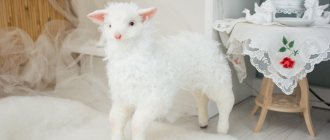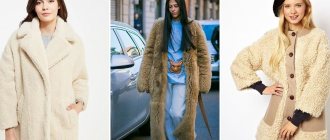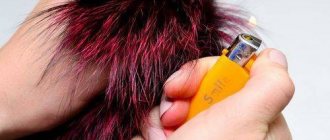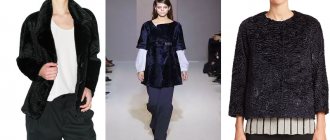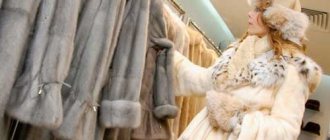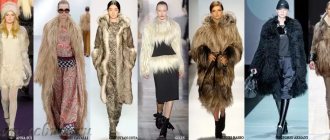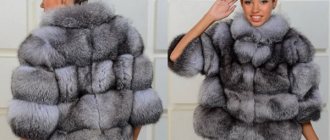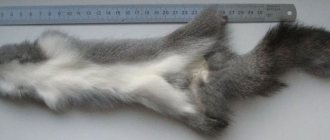A fur coat is not a luxury in Russia. By and large, fur clothing can be fully perceived as a necessity. However, furs are not affordable for everyone. Mink coats and arctic fox coats can easily be valued at hundreds of thousands of rubles. However, you can always find an affordable fur coat option. Perhaps it will not look like mink, but in terms of its performance characteristics it will not only be inferior to it, but will also surpass it in a number of parameters.
On the website https://mexa-ekaterina.ru/ you can find a wide selection of fur products. The store is attractive because it provides exceptionally high-quality products. There is often deception in the fur business. This is something to keep in mind. Below you will find fur that is recommended for purchase by almost every girl due to its unique characteristics.
Curly fur
Curly (from English curly) sheepskin fur of the Kalgan breed.
The fur is made from the skins of young lambs, which makes it light and weightless in appearance. Natural raw materials are supplied to production exclusively from Southern Mongolia, where animals are raised, then the sheepskin fur is processed without adding chemicals to production. A distinctive feature of curlie fur coats is their small curly curls, making the products soft to the touch and pleasant to wear. Such fur coats are more like coats - the fur is less voluminous, but the elegance and attractiveness are beyond any competition.
As a rule, most often at fashion shows you can see jackets and sheepskin coats made from young lambs. Curly products do not require special care, have a long service life and fit perfectly.
Tuscany fur: lamb of the highest quality
Tuscans are a special breed of sheep. In general, sheepskin is often used for the production of fur products. An example is the doodle. The advantages of sheepskin are obvious - it does not add visual volume like any other fur.
At the same time, sheep fur is very warm due to its structure, but at the same time light. Strictly speaking, it is precisely because of these characteristics that sheepskin coats have become so popular almost everywhere.
However, Tuscany fur is a special case. The main distinguishing feature of these sheep is their long and straight fur, which is unusual for other breeds. If, before choosing a fur coat from Tuscany, you try on fur products from any other long-haired fur, then you will see how much lighter and more comfortable Tuscany lies on your shoulders.
Of course, the price of such a fur product is higher. But even with regular use, such a fur coat will be much more comfortable in the long term.
Advantages of curly fur coats
- Weather resistant. The fur does not deform from rain and snow, does not shrink, and does not spread.
- Keeps you warm. The effect is achieved due to the thin pile and thick undercoat.
- Excellent fit. Curly products are quite elastic and fit perfectly.
- Not subject to crushing. The fur does not require steaming or ironing; after creasing, it immediately smoothes out.
- Dense layer of flesh. Leather is wear-resistant, durable, does not wear off or crack over time.
Differences between regular sheepskin and curlie
First of all, there is a fairly big difference in price between sheepskin and curlie. Unfortunately, because of this, you can find many fakes on the markets, but there are a number of differences that you need to pay attention to when purchasing:
— Strongly curly fur is characteristic of the sheepskin of the Kalgan breed, and it is from this that Curley fur coats are made.
- Mezdra (leather) is very similar to suede, but has a fine pile.
- Due to its excessive thickness and hairiness, curlie retains human warmth.
- Easy-going. The natural fur coats of young lambs are very fluffy and can weigh around 1.5 kilograms, while a similar product made from mouton would weigh 2.5-3 kg.
The most fashionable fur of the season
The cyclical nature of fashion periodically pulls out forgotten silhouettes and cut lines from “grandmother’s chest” (adjusted for modernity, of course) and brings traditional fabrics and materials back to life.
The fashion for fur products is more conservative than for seasonal ones - after all, the pleasure is not cheap, not everyone can afford to change their fur coat every year. But this fashion is also subject to a change in favorites, both in terms of design and principles of processing and sewing of products, and in terms of the choice of raw materials.
Every season, fashion magazines and famous stylists declare something “the latest”: either dyed fluffy fur in a voluminous silhouette, or a noble mink in strict lines, or a long-haired goat or yak in folk style products.
But there is one type of fur - astrakhan fur, which has been present in the wardrobe for a long time in one form or another, and was worn by both men and women.
And this is fur - the democratic scribble we all know.
There are three types of astrakhan according to the type of origin.
1. Uzbek astrakhan fur is the ancestor of this beautiful fur. The first astrakhan sheep were bred in Bukhara. The most common and inexpensive type of karakul. The curl is dense, small, often concentric or “bob” shaped. The flesh is dense, thick, the size of the skin is from small to medium. Due to the small curl, this type of astrakhan fur is now considered not very popular, since the modern fashion for astrakhan fur gravitates towards fur with a flatter ribbed curl.
2. Afghan karakul is a close “relative” of the Uzbek one. Differences appear both in the size of the skins - in the Afghan they are generally larger, and in the curl pattern - it is flatter, smoother. The most common type of karakul today. Lightweight and with a shine unique to this type.
3. Swakara is the most expensive type of karakul of South African origin. The curl is flatter and linear, the skins have a thin but dense core, the size of the skins is from medium to large. Swakara's specialty is milky-white karakul - the result of the painstaking work of South African breeders.
The selection affected not only the appearance of the fur, but also its color scheme. Natural astrakhan fur is usually black, gray or brown in color.
It is believed that the word “ karakul ” comes from two words: “kara” - “black” and “gul” - “rose”. In Central Asia, black astrakhan fur is treated like a luxurious flower - a “black rose”. But besides black scribble, there is also a colored one. According to the color of the hair, astrakhan fur is divided into four main groups: sur, plain brown, plain other colors and variegated.
Sur - astrakhan fur with uneven color along the length of the hair: dark at the base, gradually turning to lighter at the ends of the hair. In the karakul colors of suras, the following colors are distinguished:
- silver - dark smoky or black hair at the base with a transition to light silver at the ends of the hair;
- golden - dark hair at the base with a transition to golden at the ends of the hair;
- bronze - brown hair of all shades at the base with a gradual transition to light bronze or orange at the ends of the hair;
- amber - brown hair at the base with a gradual transition to amber at the ends of the hair;
- platinum - dark brown or coffee-colored hair at the base with a gradual transition to light cream at the ends of the hair;
- steel - black hair at the base with a gradual transition to white or steel at the ends of the hair;
- apricot flower - dark brown or dark orange hair with a gradual transition to a delicate beige-brown color with a bluish tint at the ends of the hair.
Solid brown astrakhan fur has a uniform brown coat of different shades, from dark to light brown. Brown skins are characterized by a khalili coloring, brown with black spots or black with brown spots, symmetrically located on the skin, as well as bordering the edges with another hair that differs in color from the main one. Plain astrakhan of other colors is characterized by hair of all shades of gray and brown, monochromatic coloring, as well as black hair with gray hair, “with frost.”
White - white hair, black spots on the face, ears and legs are allowed. Motley - hair coat with pinches, spots with an area of more than 12 cm of a different color compared to the main one on the rest of the skin area, except the head, tail and legs. Pink or guligaz (tamarisk flower) is a hairline of pink shades ranging from dark to light pink, consisting of mixed white and brown hairs.
And here is an example of a white scribble - swakara.
The closest relative of the astrakhan is the broadtail . Both are lamb skins, differing only in the time of slaughter. Karakul is obtained from the slaughter of two- and three-day-old lambs, and astrakhan is the prepared skins of unborn Astrakhan sheep. A special feature of broadtail is the curls that have not yet had time to form. Short hair fits tightly to the skin, creating a unique moire pattern. The spine and flesh, which have not had time to harden, give weightlessness to the broadtail (smushka) and the extraordinary thinness of the material.
Karakulcha provides special value for modern fashion trendsetters. Products made from it are not cheap, which is explained by the laboriousness of selecting the same type of pattern.
Karakul of purebred Karakul sheep is silky, dense with various curls. There are several types of curls: roller, mane, bob, ring, half-ring, corkscrew, lasa, polka dot.
Skins of mixed-breed lambs (from coarse-wool and Karakul sheep) - with rough hair. They are slightly silky, glassy-shiny or matte. Skins with varying degrees of curl.
Smushka - skins of lambs of Smushka sheep breeds, aged 2-4 days. The fur is soft, slightly shiny or matte, the curls are similar to astrakhan fur, but looser and even braided.
The skins of fine-fleece, semi-fine-wool, semi-coarse-wool and coarse-wool lambs are divided into several types:
- moire - with low hairline, with a moire pattern;
- klyam - with low raised hairline, consisting of manes and ridges;
- hake - with soft or slightly rough, glassy-shiny or matte hair, forming curls of various shapes (in skins - mainly on the ridge and rump);
- strap - soft hair, which consists of curls in the form of rings or polka dots;
- shakes and sak-sak - soft silky hair, consisting of ring-shaped and corkscrew-shaped curls.
Since time immemorial, astrakhan fur has been used for sewing men's hats - papakhas - among different nations. The Caucasus and Transcaucasia, Central Asia, the Carpathians, Moldova... The national headdress is still common in these regions, and the papakha is an integral attribute of the folk costume and a source of male pride.
For a Caucasian, a hat is not only part of a costume, but also a symbol of honor and dignity. Aksakals often say: “If the head is intact, there should be a papakha on it”, “If you have no one to consult with, consult with your papakha” - such proverbs and sayings emphasize the importance of the papakha for Caucasians a.
The Cossacks adopted a lot from the mountain peoples in terms of folk costume, including the hat.
Since the mid-1800s, astrakhan hats were officially introduced into the Cossack uniform.
In the Russian army from the mid-19th century. The papakha was the headdress of the troops of the Caucasian Corps and all Cossack troops, since 1875 - also of units stationed in Siberia, and since 1913 - the winter headdress of the entire army.
We see bekes, trimmed with astrakhan fur, among the Cossack officers.
And these are our contemporaries...
In the Soviet Army, colonels, generals and marshals wear hats in winter.
The popularity of karakul in everyday “civilian” clothing has not always been high. Astrakhan coats, hats, as well as cuffs and collars began to become widespread in the 19th century.
With the beginning of the 20th century, clothing manufacturers began to experiment by combining astrakhan fur with other types of fur. The 20th century was greeted by girls who never picked up anything heavier than a muff wearing elegant hats and fitted jackets trimmed with fur. Soon, clothing made from such fur became not just a fashionable novelty, but a kind of indicator of the status of its owner, his belonging to persons of the highest rank.
In the USSR, astrakhan hats and collars were distinctive elements of the outfits of senior civil servants. Formal coats and fur coats were certainly in the wardrobe of the spouses of high-ranking persons.
We all probably remember my mother’s fur coat - “standing up”, heavy, black... And again, “pie” hats, but for men and for members of the Politburo.
After the collapse of the Union, the excitement around karakul subsided somewhat, and the demand for it began to revive again relatively recently.
The invention of new methods for processing skins, the departure from strict classical lines and the search for interesting design ideas have once again returned astrakhan fur to the list of popular types of fur. In the 90s, Ralph Lauren released an original collection that emphasized Russian motifs. Astrakhan collars and kubankas as elements of a fashionable outfit attracted the interest of many fur fans, and by the beginning of the 2000s, astrakhan fur confidently migrated to the collections of Dior, Prada, Armani, and Gucci.
At the forefront of fashion in the fall-winter 2014/2015 season is astrakhan fur in various forms.
Modern technologies for processing skins, design ideas for using fur and current cutting lines transform karakul into both traditional outerwear and skirts, dresses, pullovers and jackets.
Astrakhan fur’s resistance to moisture, wind, low thermal conductivity, combined with lightness and small thickness, made the fur optimal for sewing demi-season items, which are most often tested by rain and slush. The shine and silkiness of the fur gives it elegance and presentability.
Properly selected astrakhan clothing has a slimming effect. Proper storage and careful care will ensure that an astrakhan product always looks attractive for five to six seasons.
Today Karakul is painted in different colors and everything is sewn from it - from a fur coat to a dress, from bags to shoes...
Men are not forgotten either - fashion designers offer them no less interesting silhouettes, details, and finishes. I think it's quite nice.
For those who cannot imagine wearing natural fur, artificial astrakhan fur is produced, sometimes indistinguishable from the real thing.
It’s up to you to decide what to use for your most beautiful fur coat – natural fur or faux fur. In any case, in astrakhan clothes you will feel fashionable and modern.
Curly fur care
As is already known from the above, fur does not require special care, which is its main advantage. However, it is still worth observing a number of simple standard rules that apply to all products. It is better to dry the product on hangers in a straightened form; in no case should it be heated by heating devices. It is also worth taking care and protecting your fur coat from moths and direct sunlight.
Do not pack coats in sealed containers. If dirt appears on the fur, you need to take it to the dry cleaner. You should not remove the stain yourself, as this may damage the product.
Before storing the item until the next season, it is necessary to carry out the cleaning and ventilation procedure, and only then put it into storage. By applying these tips, you will preserve the original appearance of the product, its softness and shine for a long time, thereby extending its service life.
